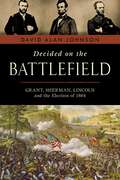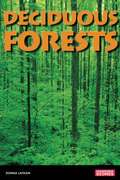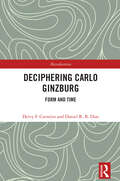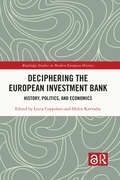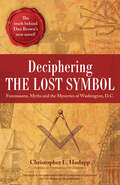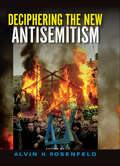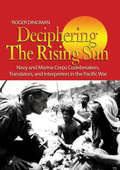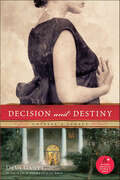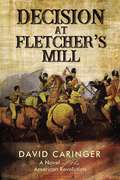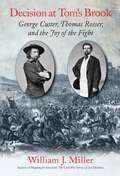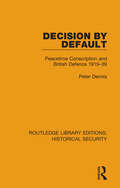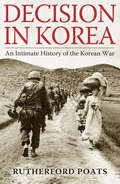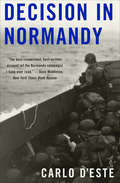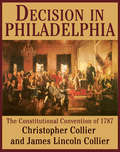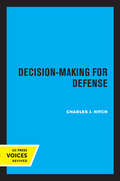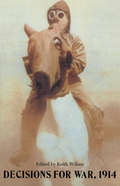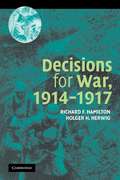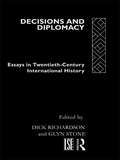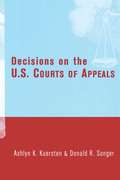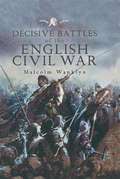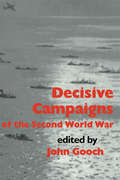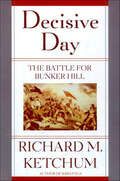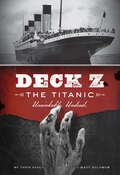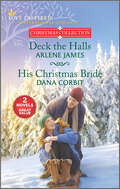- Table View
- List View
Decided on the Battlefield: Grant, Sherman, Lincoln and the Election of 1864
by David Alan JohnsonIn the summer of 1864, the American Civil War had been dragging on for over three years with no end in sight. Things had not gone well for the Union, and the public blamed the president for the stalemate against the Confederacy and for the appalling numbers of killed and wounded. Lincoln was thoroughly convinced that without a favorable change in the trajectory of the war he would have no chance of winning a second term against former Union general George B. McClellan, whom he had previously dismissed as commander of the Army of the Potomac. This vivid, engrossing account of a critical year in American history examines the events of 1864, when the course of American history might have taken a radically different direction. It's no exaggeration to say that if McClellan had won the election, everything would have been different-McClellan and the Democrats planned to end the war immediately, grant the South its independence, and let the Confederacy keep its slaves. What were the crucial factors that in the end swung public sentiment in favor of Lincoln? Johnson focuses on the battlefield campaigns of Generals Ulysses S. Grant and William Tecumseh Sherman. While Grant was waging a war of attrition with superior manpower against the quick and elusive rebel forces under General Robert E. Lee, Sherman was fighting a protracted battle in Georgia against Confederate general Joseph E. Johnston. But then the president of the Confederacy, Jefferson Davis, made a tactical error that would change the whole course of the war. This lively narrative, full of intriguing historical facts, brings to life an important series of episodes in our nation's history. History and Civil War buffs will not want to put down this real-life page-turner.
Deciduous Forests
by Donna LathamInvestigating the planet's biomes and examining the modern threats to each ecosystem, this interactive series challenges young readers to look at how their own actions influence the planet's health. With compare-and-contrast facts and vocabulary-building sidebars, each engaging guide reveals how environmental threats-both human and natural-affect plants and animals.Showcasing the diverse woodland of deciduous forests, this resource reveals how many of its threats come from humans. Covering topics such as deforestation, acid rain, disease, and invasive species, this engaging guide shows how, in the complicated web of life in the forest, even natural threats can be made worse by human activity.
Deciphering Carlo Ginzburg: Form and Time (ISSN)
by Deivy F. Carneiro Daniel R. DiasThis book offers an original reading of Carlo Ginzburg’s work, tracing his trajectory in the context of Italian micro-history, his debates on the objectivity of historical knowledge, and the connection of his work to the expanded perspectives constructed in recent decades by global history.Ginzburg's theories have achieved notoriety not only in the field of history but also among the wider public. This volume uses Ginzburg’s own aesthetic and intellectual practices in its analysis, and it deciphers the elements that drove and influenced the making of his work. By highlighting the procedures that Ginzburg has constructed to respond to problems of cultural history, the book also pays close attention to Erich Auerbach and Aby Warburg, whose influences played a crucial role in reformulating Ginzburg’s conception of micro-history. From there, the volume demonstrates the radicality of Ginzburg's micro-history through the discussion of some of his most recent contributions to international historiographical debates.Thought-provoking and thoroughly researched, Deciphering Carlo Ginzburg is an innovative study in Ginzburg’s methods and theories.
Deciphering the European Investment Bank: History, Politics, and Economics (Routledge Studies in Modern European History)
by Lucia CoppolaroDeciphering the European Investment Bank: History, Politics and Economics examines the European Investment Bank (EIB), the European Union’s financial institution and the largest lender and borrower among the International Financial Institutions. Since its establishment in 1958, the EIB has developed without becoming front-page news and has remained highly invisible. By putting together fourteen chapters that analyze topical and meaningful moments and aspects of the bank, this edited book offers the first comprehensive analysis of its origins and its evolution in terms of its mandate, governance, structures, policy activity, and performance. Written by acknowledged experts from various disciplines, the chapters weave together history, economics, law, and political science to provide a multidisciplinary examination and capture the complexity of the EIB. The book is a timely initiative for understanding the EIB, whose role has been ever increasing for contributing to the recent global economic challenges, including the economic and financial crisis, climate change and COVID-19 pandemic. The chapters are written at a level which will be comprehensible to undergraduates in economics, history, and international political economy. It will also be a valuable source of reference for academics, policy makers, bankers, and other practitioners interested in regional development banks and their role in the global economy.
Deciphering the Lost Symbol: Freemasons, Myths and the Mysteries of Washington, D.C.
by Christopher I HodappDiscover the secretive brotherhood behind Dan Brown’s The Lost Symbol in this unauthorized companion book by the author of Solomon’s Builders.Freemason influence on the founding of Washington, D.C., is evident throughout the city’s buildings, statues and monuments—but it’s written in coded symbols that few people understand. Dan Brown’s thriller sends symbologist detective Robert Langdon through the capital to unravel its Masonic secrets. Now in Deciphering The Lost Symbol, Freemason expert Christopher L. Hodapp compares each clue and plot twist in Brown’s story to the true facts.•Discover the meaning of “The Lost Word”•Decode Masonic and alchemical symbolism•Explore the innermost rooms of Masonic lodges and temples•Visit the restricted area of the U.S. Capitol and other landmarks•Uncover secret patterns in Washington, D.C.’s maps and monuments•Crack the codes buried in The Lost Symbol’s artwork and puzzles“Confident in recommending it to everyone, Mason and non-mason alike. This is the perfect a compliment to The Lost Symbol and I feel it should be on the shelf right next to it on your bookcase.” —David Naughton-Shires, Masonic Art Exchange
Deciphering the New Antisemitism (Studies in Antisemitism)
by Alvin H. RosenfeldDeciphering the New Antisemitism addresses the increasing prevalence of antisemitism on a global scale. Antisemitism takes on various forms in all parts of the world, and the essays in this wide-ranging volume deal with many of them: European antisemitism, antisemitism and Islamophobia, antisemitism and anti-Zionism, and efforts to demonize and delegitimize Israel. Contributors are an international group of scholars who clarify the cultural, intellectual, political, and religious conditions that give rise to antisemitic words and deeds. These landmark essays are noteworthy for their timeliness and ability to grapple effectively with the serious issues at hand.
Deciphering the Rising Sun
by Roger DignmanThis book is the first to document the vital role played by Americans, not of Japanese ancestry, who served as Japanese language officers in World War II. Covering the period 1940-1945, it describes their selection, training, and service in the U.S. Navy and Marine Corps during the war and their contributions toward maintaining good relations between America and Japan thereafter. Author Roger Dingman argues that their service as codebreakers and combat interpreters hastened victory and that their cross-cultural experience and linguistic knowledge facilitated the successful dismantling of the Japanese empire and the peaceful occupation of Japan. He shows how the war changed relations between the Navy and academia, transformed the lives of these 1,200 men and women, and set onetime enemies on a course to enduring friendship. The book s purpose is twofold: to reveal an exciting and previously unknown aspect of the Pacific War and to demonstrate the enduring importance of linguistic and cross-cultural knowledge within America s armed forces in war and peace. The book is meant for general readers interested in World War II, as well as those with an interest in America's intelligence establishment and those fascinated by Japan and its relations with the United States. Based on extensive interviews with the language officers and on their wartime letters and unpublished memoirs, this history reveals how brains and a devotion to duty allowed these officers to learn an extraordinarily difficult language and use it to hasten Japan s defeat as well as to assist the transformation of the Japanese from enemy to friend of America. It is also, the author notes, a telling example of how empathy and cross-cultural understanding rather than brute force and coercion can lead to greater production of valuable intelligence and active collaboration.
Decision and Destiny: Colette's Legacy (Colette Ser. #2)
by DeVa GanttA spellbinding saga of a remarkable american family . . .The beautiful, frail Colette Duvoisin trusted governess Charmaine Ryan with her worries, her dreams, and the care of her beloved children. But now Colette is gone—leaving her three young ones devastated . . . and the house of Duvoisin in turmoil.To her children's horror, their father, the enigmatic Frederic Duvoisin, weds his mistress and sister-in-law, Agatha, soon after their mother's untimely death. A scheming and dangerous adversary, Agatha has no love for her predecessor's offspring, ruthlessly wielding her newly won power while guarding her own dark secrets. Meanwhile, a rivalry between Colette's stepsons—suave Paul and cynical John—is reignited, drawing battle lines among family, friends, and servants. When Frederic suddenly emerges from his self-imposed isolation, he touches off a struggle for patriarchal supremacy that threatens to lay the entire Duvoisin empire to waste.At the center of the storm is innocent Charmaine, who must come to terms with shattering truths about the family she once believed she knew—and decide who among them deserves her admiration, her derision, her devotion . . . and her heart.
Decision at Fletcher’s Mill: A Novel of the American Revolution
by David CaringerThe American revolution has no end in sight. Slavery has plagued the southern colonies as long as anyone can remember. The British have opened a second front in the south. Southern society is fragmented as rebels strive to throw off British tyranny, while loyalists fight to remain under English rule. Neighbor turns against neighbor. Families are torn apart.Young Billy Morgan enters this chaotic world as a militiaman during the decisive battle of Cowpens. He becomes the butt of many jokes before the battle by trying to gain acceptance from his comrades through a foolish boastful lie. At Cowpens, the other men learn that there is much more to Billy Morgan than any of them thought possible when he leads them into the fiercest part of the fight. He is rewarded with a promotion and given a task that is much larger than his limited experience and apparently questionable character would seem to support.Ira Fletcher is one of the richest men in South Carolina. He has powerful political connections. Fletcher is a complex man with a fiery past, and a passion for the Gospel. He owns Fletcher’s Mill and almost everything around it for miles. Rumors abound regarding vast treasure hidden in or under the mill. Ira abhors slavery. He elevates former slave, Ezekiel, to a position of authority at the mill. Elizabeth, Ira’s orphaned granddaughter, is raised by the widowed Ira, Ezekiel, and family friend Mona Partridge. The jealousy of His planter neighbors explodes into cruel violence that threatens everything Ira holds dear. He is forced to choose what is truly valuable.Love and loyalty, greed and violence, courage and grace all abound as these people and many others are drawn together. Choices must be made. Change is coming. It is a time of weighty decision at Fletcher’s Mill.
Decision at Tom’s Brook: George Custer, Tom Rosser, and the Joy of the Fight
by William J. MillerThe Battle of Tom’s Brook, recalled one Confederate soldier, was “the greatest disaster that ever befell our cavalry during the whole war.” The fight took place during the last autumn of the Civil War, when the Union General Phil Sheridan vowed to turn the crop-rich Shenandoah Valley into “a desert.” Farms and homes were burned, livestock slaughtered, and Southern families suffered. The story of the Tom’s Brook cavalry affair centers on two young men who had risen to prominence as soldiers: George A. Custer and Thomas L. Rosser. They had been fast friends since their teenage days at West Point, but the war sent them down separate paths—Custer to the Union army and Rosser to the Confederacy. Each was a born warrior who took obvious joy in the exhilaration of battle. Each possessed almost all of the traits of the ideal cavalryman—courage, intelligence, physical strength, inner-fire. Only their judgment was questionable. Their separate paths converged in the Shenandoah Valley in the summer of 1864, when Custer was ordered to destroy, and Rosser was ordered to stop him. For three days, Rosser’s gray troopers pursued and attacked the Federals. On the fourth day, October 9, the tables turned in the open fields above Tom’s Brook, where each ambitious friend sought his own advancement at the expense of the other. One capitalized upon every advantage fate threw before him, while the other, sure of his abilities in battle and eager to fight, attempted to impose his will on unfavorable circumstances and tempted fate by inviting catastrophe. This long-overlooked cavalry action had a lasting effect on mounted operations and influenced the balance of the campaign in the Valley. Based upon extensive research in primary documents and gracefully written, award-winning author William J. Miller’s Decision at Tom’s Brook presents significant new material on Thomas Rosser, and argues that his character was his destiny. Rosser’s decision-making that day changed his life and the lives of hundreds of other men. Miller’s new study is Civil War history and high personal drama at its finest.
Decision by Default: Peacetime Conscription and British Defence 1919–39 (Routledge Libary Editions: Historical Security)
by Peter DennisBritain’s vast losses of men in the first world war produced a revulsion against conscription. Originally published in 1972, Peter Dennis here describes how conscription was introduced once more in 1939, when pressure from within Britain and from France forced the British Government to reverse its position. With the use of original sources, Peter Dennis explores the development of British military policy between the wars, from the period of readjustment and realignment immediately after the first world war, up to the breakdown of the Chamberlain government’s pledge not to introduce conscription in peacetime. He points out that the politicians and the public were not afraid of conscription itself, but of conscription in peacetime as the forerunner of continental military adventures in alliance with France. He shows how the battles over conscription had a marked effect on the indecision of military thinking, and how, in 1939, conscription finally became the crucial issue in Britain’s preparation for war.
Decision in Korea
by Rutherford M. PoatsDecision in Korea, first published in 1954, is, as the author states, “a reporter’s survey” of the Korean conflict from its beginning through the first half year of the armistice. In scope, author Poats provides an excellent overview of the larger military and political aspects of the war, interspersed with personal stories of its fighting men and political leaders. Today, the book remains a useful, clearly written reference for explaining this confusing, tragic conflict. Rutherford Poats was head of the Japan bureau of the United Press and spent much time with United Nations forces in Korea during the fighting and peace-process. Included in this new edition are 4 maps and the complete text of the Armistice agreement.
Decision in Normandy
by Carlo D'EsteThe strategy and planning behind D-Day: &“The best-researched, best-written account [of the Normandy Campaign] I have ever read.&”—The New York Times Book Review One of the most controversial and dangerous military operations in the history of modern warfare, the battle for Normandy took over two years of planning by each country that made up the Allied forces. The event is mired to this day in myth and misconception, and untangling the web of work that led to D-Day is nearly as daunting as the work that led to the day itself. Drawing from declassified documents, personal interviews, diaries, and more, Carlo D&’Este, a winner of the Pritzker Award, uncovers what really happened in Normandy. From what went right to what went wrong, D&’Este takes readers on a journey from the very first moment Prime Minister Churchill considered an invasion through France to the last battles of World War II. With photos, maps, and first-hand accounts, readers can trace the incredible road to victory and the intricate battles in between. A comprehensive look into the military strategy surrounding the Second World War, Decision in Normandy is an absolute essential for history buffs. &“A fresh perspective on the leadership of Field Marshal Bernard Montgomery and the Allied landings after D-Day.&”—Publishers Weekly &“Again and again he reveals new facets of familiar subjects—in part from his own dual American army and British academic background; in part by querying everyone and everything.&”—Kirkus Reviews
Decision in Philadelphia: The Constitutional Convention of 1787
by James Lincoln Collier Christopher CollierIncludes a complete copy of the Constitution. Fifty-five men met in Philadelphia in 1787 to write a document that would create a country and change a world. Here is a remarkable rendering of that fateful time, told with humanity and humor. "The best popular history of the Constitutional Convention available. "--Library Journal From the Paperback edition.
Decision-Making for Defense
by Charles J. HitchWhen President Kennedy appointed Robert McNamara Secretary of Defense in January, 1961 and McNamara called on Charles Hitch to join him, a new era of defense policy leadership was clearly at hand. Great problems of organization had emerged along with vast increases in American responsibility for the security of the free world in the post-war era of rapidly changing military technology. Defense department unification and other controversial questions of organization of the defense establishment assumed new dimensions with the advent of the new techniques of planning and analysis. Hitch discusses, from the rare perspective of an analytically gifted insider, how the Department of Defense achieved balanced programs and more effective forces through the firm application of the new management techniques without sweeping changes of organization structure. Important challenges still lie ahead. As Hitch says: "The objectives, the organization, and the management techniques of national defense are all interrelated. Organization and procedures must be adapted to our changing nationaal policies and objectives as well as to changes in the character of our resources and technologies. It will take all our ingenuity and skill to make these necessary adaptations so that we can continue to provide unified management of so great an enterprise as our present military establishment. At the beginning of our Constitutional history the building of three frigates and the management of a few companies to fight Indians were considered too great a task for the War Department alone." Management of the American defense establishment has been a subject of fascination, concern and occasional despair to generation of Presidents, legislators, military leaders, and informed citizens. Hitch provides historical perspective on these tasks of decision-making for national security, and he explains clearly and succinctly the contemporary problems of fitting together strategic alternatives, weapons technology, and economic resources to achieve a rational pattern of defense management. The modern tools for this task are new techniques of planning, programming, and budgeting, and, for evaluating complex situations, the methods of systems analysis, all of which are discussed in detail. Hitch was involved both in the origination of these management techniques while at the RAND Corporation and in the tremendous task of putting them to consistent, far reaching, and practical use in the Department of Defense. President Johnson termed Hitch "a principal architect of America's modern defense establishment . . . It is largely as a result of [his] efforts that this country now possesses the most balanced, flexible, combat-ready defense force in history and management system to maintain our superior military posture and use it with precision." This title is part of UC Press's Voices Revived program, which commemorates University of California Press's mission to seek out and cultivate the brightest minds and give them voice, reach, and impact. Drawing on a backlist dating to 1893, Voices Revived makes high-quality, peer-reviewed scholarship accessible once again using print-on-demand technology. This title was originally published in 1965.
Decisions Denied: Women's Access to Contraceptives and Abortion in Argentina
by Human Rights WatchThe 85-page report, "Decisions Denied: Women's Access to Contraceptives and Abortion in Argentina," documents how judges, doctors and health workers prevent women from making independent reproductive decisions in violation of women's internationally recognized human rights. The report also exposes some of the detrimental effects of domestic violence on women's reproductive health. The Argentine government has not done enough to remedy these abuses and their effects on women's health, Human Rights Watch said. Women's severely limited access to safe and legal abortions in Argentina is inconsistent with international law because it threatens the rights to life, health, equality, privacy, physical integrity, and freedom of religion and conscience. Amid continuing barriers to contraception, an estimated 40 percent of all pregnancies end in an illegal and therefore unsafe abortion in Argentina today. The consequences of illegal abortions have been the leading cause of maternal mortality for two decades. Human Rights Watch called on the Argentine government to protect women's human rights to health, life, nondiscrimination, privacy, physical integrity, information, freedom of religion and conscience, equal enjoyment of rights, equal protection under the law, and the right to make decisions about the number and spacing of children.
Decisions For War, 1914
by Keith WilsonKeith Wilson is Lecturer in International History at the University of Leeds.; This book is intended for undergraduate history courses: broad 20th century European history, First World War, military history, war studies, international and diplomatice history, school libraries.
Decisions For War, 1914-1917
by Holger H. Herwig Richard F. HamiltonFocusing on the choices made by coteries, this study examines the perplexing question of why World War I happened. In each case, the decision to enter the war was made by a handful of individuals--monarchs, ministers, military people, party leaders, ambassadors, and a few others. In each case also, separate and distinct agendas are seen, with considerations differing from one nation to the next. The leadership of Japan, the Ottoman Empire, Italy, the Balkans, and the United States are explored, as well as that of the major powers involved--Austria-Hungary, Germany, France, and Great Britain,
Decisions and Diplomacy: Studies in Twentieth Century International History
by Glyn Stone Dick RichardsonThe growing significance of international history and relations in recent years has been reflected in a growth of research and development of new courses. This collection of essays focus on three broad themes: the League of Nations and collective security, problems in British foreign policy, and European/International security in the interwar years. The book, in memory of Esmonde Robertson and George Grün, distinguished historians of the London School of Economics, contains papers commissioned from some of the most formidable names in international history.
Decisions on the U.S. Courts of Appeals: Examining Judicial Process And Decision Making On The U. S. Courts Of Appeals (Constitutionalism And Democracy Ser.)
by Ashlyn Kuersten Donald SongerThis book provides institutional information as well as practical usage information on the U.S. Courts of Appeals. In addition, it includes important statistical information for researchers and students interested in a variety of topics less directly related to the judiciary.
Decisive Battles of the English Civil War: Myth And Reality
by Malcolm WanklynIn this stimulating and original investigation of the decisive battles ofthe English Civil War, Malcolm Wanklyn reassesses what actually happened on the battlefield and as a result sheds new light on the causes of the eventual defeat of Charles I. Taking each major battle in turn - Edgehill, Newbury I, Cheriton, Marston Moor, Newbury II, Naseby, and Preston - he looks critically at contemporary accounts and at historians' narratives, explores the surviving battlegrounds and retells the story of each battle from a new perspective. His lucid, closely argued analysis questions traditional assumptions about each battle and the course of the war itself.
Decisive Campaigns of the Second World War
by John GoochSuccess or defeat in the Second World War turned less on winning or losing battles than on winning or losing campaigns. This volume reassesses the importance of seven major campaigns for the outcome of the war. The authors examine a wide range of factors which influence success or failure including strategic planning, logistics, combat performance, command and military intelligence. This book represents a novel contribution to the study of the Second World War.
Decisive Day: The Battle for Bunker Hill
by Richard M. KetchumThe author of The Winter Soldiers recounts the early developments of the American Revolution and an important battle in Boston.Boston, 1775: A town occupied by General Thomas Gage’s redcoats and groaning with Tory refugees from the Massachusetts countryside. Besieged for two months by a rabble in arms, the British decided to break out of town. American spies discovered their plans, and on the night of June 16, 1775, a thousand rebels marched out onto Charlestown peninsula and began digging a redoubt (not on Bunker Hill, which they had been ordered to fortify, but on Breeds Hill, well within cannon shot of the British batteries and ships). At daybreak, HMS Lively began firing.It was the opening round of a battle that saw unbelievable heroism and tragic blunders on both sides (a battle that marked a point of no return for England and her colonies), the beginning of the Revolutionary War.
Deck Z: The Titanic
by Chris Pauls Matt SolomonThis fast-paced thriller reimagines the historical events of the doomed Titanic voyage—with an outbreak of zombie mayhem. Desperate to keep a terrifying new virus out of the wrong hands, a German scientist smuggles the lone sample onto the RMS Titanic. But he’s followed by a government agent, and the ensuing spy games unleash a zombie plague. With the 2,200 passengers sailing to New York, Capt. Edward Smith and his inner circle desperately try to contain the growing horde. Smith’s team is forced into bloody hand-to-hand combat down the narrow halls of the huge steamer. In its few short days at sea, the majestic Titanic turns into a Victorian bloodbath, steaming at top speed toward a cold, blue iceberg.
Deck the Halls and His Christmas Bride
by Dana Corbit Arlene JamesA family for ChristmasDeck the Halls by Arlene JamesRetrieving the mail from his old apartment brought more than just letters for Vince Cutler. When he opened the door on the lovely Jolie Wheeler and rooms he hardly recognized, he knew he’d found the person to fix up his bare new bachelor quarters. Vince’s family reminded Jolie achingly of her own loss. Could the spirit of Christmas work within Jolie’s heart to reconnect her with her family…and with Vince?His Christmas Bride by Dana CorbitlDylan Warren’s childhood best friend, Jenna Scott, broke his heart. Now their matchmaking mothers insist the Warren and Scott clans celebrate the holiday together. Suddenly he and Jenna are paired on a mission to bring Christmas to a family who lost everything but each other. Jenna’s kindness reminds Dylan why he loved her. Could joyful jingle bells soon be joined by the chime of wedding bells?
